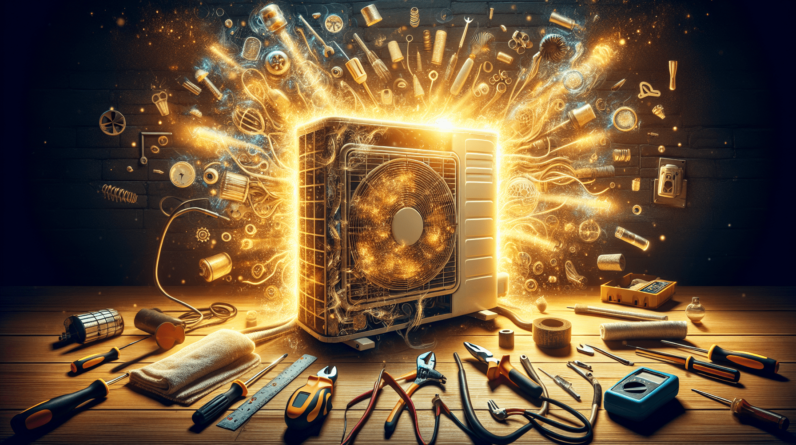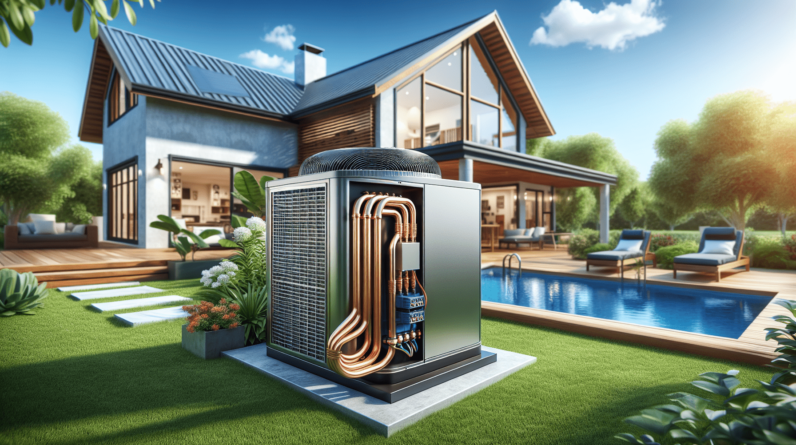

When it comes to our HVAC systems, we rely on them to diligently and efficiently regulate our indoor climate. However, just like any other mechanical equipment, these systems aren’t immune to occasional malfunctions. So, when that dreaded moment arrives and your HVAC starts acting up, it’s useful to know which part is most likely to cause trouble. In this article, we will explore the most common component that tends to fail in HVAC systems, shedding light on why it happens and what you can do to minimize the risk of encountering such issues. So, let’s dive in and discover the culprit behind those HVAC headaches!

Compressor
Introduction to the compressor
The compressor is one of the most crucial components of an HVAC system. It plays a vital role in the cooling process by pressurizing the refrigerant and pumping it through the system. Without a properly functioning compressor, the air conditioner or heat pump would not be able to cool effectively.
Causes of compressor failure
Compressor failure can occur due to various reasons. One common cause is improper installation, where the compressor may not have been sized correctly or the refrigerant lines may not have been properly insulated. Another common cause is electrical issues, such as power surges or overheating. Additionally, poor maintenance practices, such as neglecting to change the air filter regularly or failing to clean the coils, can lead to compressor failure over time.
Signs of a failing compressor
There are several indicators that your compressor may be failing. One clear sign is reduced cooling capacity, where the air conditioner or heat pump is not able to cool the space as effectively as it used to. You may also notice strange noises coming from the compressor, such as buzzing or rattling sounds. Another sign is if the compressor frequently turns on and off rapidly, a phenomenon known as short cycling. If you experience any of these signs, it is important to have a professional HVAC technician inspect and diagnose the issue.
Preventive measures for maintaining the compressor
Proper maintenance is key to extending the lifespan of your compressor. Regularly schedule professional maintenance visits to have your HVAC system inspected, cleaned, and serviced. This will help identify any potential issues with the compressor and address them before they become major problems. Additionally, keep the surrounding area clean and clear of debris to ensure proper airflow and prevent overheating. Finally, be mindful of the system’s operating conditions. Avoid running the unit excessively or at extreme temperatures, as this can put extra strain on the compressor and increase the risk of failure.
Condenser Fan Motor
Introduction to the condenser fan motor
The condenser fan motor plays a crucial role in the heat dissipation process of the HVAC system. It is responsible for pulling air through the condenser coils, which allows the refrigerant to release heat and cool down. Without a functioning condenser fan motor, the system’s cooling efficiency will be significantly reduced.
Causes of condenser fan motor failure
There are several factors that can contribute to condenser fan motor failure. One common cause is lack of lubrication, which can lead to increased friction and eventually burn out the motor. Another cause is electrical issues, such as voltage fluctuations or wiring problems, that can cause the motor to overheat and fail. Additionally, exposure to harsh environmental conditions, such as extreme temperatures or excessive moisture, can also contribute to motor failure.
Signs of a failing condenser fan motor
There are a few signs that can indicate a failing condenser fan motor. One noticeable sign is reduced airflow from the outdoor unit. You may also experience decreased cooling efficiency, as the system is not able to effectively remove heat from the condenser coils. Additionally, if you hear unusual noises coming from the condenser unit, such as grinding or screeching sounds, it could be a sign of a failing fan motor. If you notice any of these signs, it is important to have a professional HVAC technician inspect and repair the motor.
Preventive measures for maintaining the condenser fan motor
Regular maintenance is key to keeping the condenser fan motor in good working condition. Ensure that the motor is properly lubricated according to the manufacturer’s recommendations. Also, make sure to clean the fan blades and remove any debris that might obstruct airflow. It is also important to regularly check the electrical connections to ensure they are secure and free from corrosion. Lastly, consider installing a protective cover or shade over the condenser unit to shield it from harsh weather conditions and prolong the lifespan of the fan motor.
Blower Motor
Introduction to the blower motor
The blower motor is responsible for facilitating the circulation of air throughout the HVAC system. It pulls air from the return ducts, forces it through the evaporator coil to cool or heat it, and then distributes the conditioned air to the different areas of the building. Without a functioning blower motor, the HVAC system would not be able to effectively regulate indoor air temperature and provide comfort.
Causes of blower motor failure
Blower motor failure can occur due to several reasons. One common cause is lack of regular maintenance, leading to the accumulation of dirt and debris on the motor blades and within the system. This can cause the motor to work harder and eventually fail. Another cause is electrical issues, such as worn-out or damaged wiring, which can prevent the motor from receiving the necessary power to function properly. Additionally, excessive heat or moisture exposure can also lead to motor failure.
Signs of a failing blower motor
There are a few signs that can indicate a failing blower motor. One noticeable sign is reduced airflow from the supply vents. You may also experience uneven heating or cooling throughout the building, as the blower motor is not able to distribute the conditioned air effectively. Unusual noises, such as squealing or grinding sounds, coming from the blower motor are also indicators of a problem. If you notice any of these signs, it is important to have a professional HVAC technician inspect and repair the motor.
Preventive measures for maintaining the blower motor
Regular maintenance is essential for ensuring the longevity of the blower motor. Make sure to clean or replace the air filters regularly to prevent the build-up of dirt and debris on the motor blades. Additionally, clean the blower assembly and lubricate the motor as specified by the manufacturer. It is also important to regularly check the electrical connections and ensure they are secure and free from damage. Finally, consider installing a programmable thermostat to optimize the operation of the blower motor and reduce unnecessary wear and tear.
Capacitor
Introduction to the capacitor
The capacitor is an important electrical component that provides the necessary boost to start the motors of various HVAC system components, such as the compressor and blower motor. It stores and releases electrical energy to help initiate the motor’s rotation. Without a functioning capacitor, the motors may struggle to start or fail to start at all.
Causes of capacitor failure
Capacitor failure can occur due to several reasons. One common cause is age, as capacitors degrade over time and can eventually fail. Overheating is another common cause, often resulting from high ambient temperatures or poor ventilation around the capacitor. Electrical issues, such as power surges or voltage fluctuations, can also contribute to capacitor failure. Additionally, exposure to moisture or contaminants can cause corrosion and damage to the capacitor.
Signs of a failing capacitor
There are a few signs that can indicate a failing capacitor. One clear sign is difficulty starting the HVAC system, where the motors may repeatedly attempt to start or not start at all. You may also notice a humming or buzzing sound coming from the system. Additionally, if you observe visible signs of damage on the capacitor, such as bulging or leaking, it is a clear indication of a problem. If you notice any of these signs, it is important to have a professional HVAC technician inspect and replace the capacitor if necessary.
Preventive measures for maintaining the capacitor
Regular maintenance is key to ensuring the proper functioning of the capacitor. Inspect the capacitor regularly for signs of damage, such as bulging or leaking. If any damage is observed, it is important to have it replaced immediately by a professional technician. Additionally, ensure proper ventilation around the capacitor to prevent overheating. Regularly schedule professional maintenance visits to have the HVAC system inspected, cleaned, and serviced. This will help identify any potential issues with the capacitor and address them before they become major problems.
Thermostat
Introduction to the thermostat
The thermostat is the control center of the HVAC system, responsible for regulating the indoor temperature and controlling the operation of the heating or cooling equipment. It senses the current temperature and instructs the system to turn on or off as needed to maintain the desired temperature. Without a properly functioning thermostat, it can be difficult to achieve and maintain comfortable indoor temperatures.

Causes of thermostat failure
Thermostat failure can occur due to various reasons. One common cause is electrical issues, such as loose or damaged wiring, which can prevent the thermostat from accurately sensing or transmitting temperature signals. Another cause is dirt or debris accumulation, which can interfere with the thermostat’s sensors and affect its performance. Additionally, improper calibration or settings can lead to inaccurate temperature readings and incorrect HVAC system operation.
Signs of a failing thermostat
There are several indicators that your thermostat may be failing. One noticeable sign is inconsistent temperatures throughout the building, where some areas may be too hot or too cold. You may also experience frequent temperature swings or difficulty reaching the desired temperature. Another sign is if the thermostat display is unresponsive or shows incorrect readings. If you notice any of these signs, it is important to have a professional HVAC technician inspect and repair or replace the thermostat if necessary.
Preventive measures for maintaining the thermostat
Regular maintenance is important for keeping the thermostat in good working condition. Check the batteries regularly and replace them as needed to ensure reliable operation. Clean the thermostat regularly to remove any dust or debris that may interfere with the sensors. Calibrate the thermostat periodically to ensure accurate temperature readings. Consider upgrading to a programmable thermostat, which can optimize energy efficiency and reduce unnecessary wear and tear on the HVAC system.
Compressor Relay
Introduction to the compressor relay
The compressor relay is an electrical component that controls the operation of the compressor. It receives the signal from the thermostat and initiates the start-up sequence of the compressor motor. Without a functioning compressor relay, the compressor may fail to start or experience issues during operation.
Causes of compressor relay failure
There are several factors that can contribute to compressor relay failure. One common cause is electrical issues, such as power surges or voltage fluctuations, which can damage the relay and prevent it from functioning properly. Another cause is overheating, often resulting from excessive use or poor ventilation around the relay. Additionally, age and wear can also degrade the relay over time, leading to failure.
Signs of a failing compressor relay
There are a few signs that can indicate a failing compressor relay. One clear sign is if the compressor fails to start or experiences difficulty starting. You may also hear clicking sounds coming from the relay, indicating that it is repeatedly attempting to start the compressor. Additionally, if you observe visible signs of damage on the relay, such as burned or melted components, it is a clear indication of a problem. If you notice any of these signs, it is important to have a professional HVAC technician inspect and replace the compressor relay if necessary.
Preventive measures for maintaining the compressor relay
Regular maintenance is important for ensuring the proper functioning of the compressor relay. Inspect the relay regularly for signs of damage, such as burns or melted components. If any damage is observed, it is important to have it replaced immediately by a professional technician. Additionally, ensure proper ventilation around the relay to prevent overheating. Regularly schedule professional maintenance visits to have the HVAC system inspected, cleaned, and serviced. This will help identify any potential issues with the compressor relay and address them before they become major problems.
Expansion Valve
Introduction to the expansion valve
The expansion valve, also known as the thermal expansion valve, is responsible for metering the flow of refrigerant into the evaporator coil. It controls the refrigerant’s pressure and temperature, allowing it to evaporate and absorb heat from the indoor air. Without a properly functioning expansion valve, the cooling process of the HVAC system would be compromised.
Causes of expansion valve failure
Expansion valve failure can occur due to several reasons. One common cause is blockage or restriction in the valve, often resulting from the accumulation of dirt, debris, or refrigerant contaminants. Another cause is refrigerant leaks, which can lead to improper functioning or damage of the valve. Additionally, exposure to extreme temperatures or vibrations can also contribute to expansion valve failure.
Signs of a failing expansion valve
There are a few signs that can indicate a failing expansion valve. One noticeable sign is reduced cooling capacity, where the air conditioner is not able to cool the space as effectively as it used to. You may also experience uneven cooling or frequent temperature fluctuations. Additionally, if you notice visible signs of refrigerant leaks around the expansion valve, such as oil stains or frost accumulation, it is a clear indication of a problem. If you notice any of these signs, it is important to have a professional HVAC technician inspect and repair or replace the expansion valve if necessary.
Preventive measures for maintaining the expansion valve
Regular maintenance is important for ensuring the proper functioning of the expansion valve. Inspect the valve regularly for signs of blockage or damage. Clean or replace the valve as recommended by the manufacturer to prevent blockage and ensure smooth operation. Additionally, ensure proper refrigerant levels and check for any signs of leaks. Regularly schedule professional maintenance visits to have the HVAC system inspected, cleaned, and serviced. This will help identify any potential issues with the expansion valve and address them before they become major problems.
Evaporator Coil
Introduction to the evaporator coil
The evaporator coil is a key component of the HVAC system’s cooling process. It is responsible for absorbing heat from the indoor air as the refrigerant evaporates within the coil. Without a properly functioning evaporator coil, the cooling efficiency of the HVAC system would be significantly reduced.
Causes of evaporator coil failure
Evaporator coil failure can occur due to various factors. One common cause is corrosion, often resulting from exposure to moisture or contaminants. Corrosion can cause leaks in the coil, leading to reduced cooling capacity and refrigerant loss. Another cause is dirt or debris accumulation on the coil, which can impede airflow and hinder the heat absorption process. Additionally, improper refrigerant charge or inadequate airflow can also contribute to evaporator coil failure.
Signs of a failing evaporator coil
There are several indicators that your evaporator coil may be failing. One clear sign is reduced cooling capacity, where the air conditioner is not able to cool the space as effectively as it used to. You may also notice uneven cooling or frequent temperature fluctuations. Additionally, if you observe visible signs of refrigerant leaks around the evaporator coil, such as oil stains or frost accumulation, it is a clear indication of a problem. If you notice any of these signs, it is important to have a professional HVAC technician inspect and repair or replace the evaporator coil if necessary.
Preventive measures for maintaining the evaporator coil
Regular maintenance is important for ensuring the proper functioning of the evaporator coil. Inspect the coil regularly for signs of corrosion, leaks, or dirt accumulation. Clean the coil and remove any debris that may hinder airflow. Ensure proper refrigerant charge and check for any signs of leaks. Regularly schedule professional maintenance visits to have the HVAC system inspected, cleaned, and serviced. This will help identify any potential issues with the evaporator coil and address them before they become major problems.
Heat Exchanger
Introduction to the heat exchanger
The heat exchanger is a critical component of the furnace in an HVAC system. It is responsible for transferring heat from the combustion process to the surrounding air, which is then distributed throughout the building. Without a properly functioning heat exchanger, the furnace may not be able to generate enough heat or may expose the indoor air to harmful combustion byproducts.
Causes of heat exchanger failure
Heat exchanger failure can occur due to several reasons. One common cause is excessive stress or wear, often resulting from prolonged operation at high temperatures or frequent on-off cycles. Another cause is poor maintenance practices, such as neglecting to clean or replace the air filter regularly, which can lead to dirt and debris accumulation on the heat exchanger. Additionally, exposure to moisture or corrosive substances can also contribute to heat exchanger failure.
Signs of a failing heat exchanger
There are a few signs that can indicate a failing heat exchanger. One noticeable sign is a strange odor, such as a musty or burning smell, coming from the furnace. You may also notice visible signs of corrosion or cracks on the heat exchanger. Additionally, if you experience frequent furnace shutdowns or if the furnace’s flame burns yellow instead of blue, it is a clear indication of a problem. If you notice any of these signs, it is important to have a professional HVAC technician inspect and repair or replace the heat exchanger if necessary.
Preventive measures for maintaining the heat exchanger
Regular maintenance is important for ensuring the proper functioning of the heat exchanger. Inspect the heat exchanger regularly for signs of corrosion, cracks, or other damage. Clean or replace the air filter regularly to prevent dirt and debris accumulation on the heat exchanger. Ensure proper ventilation to prevent excessive heat buildup. Regularly schedule professional maintenance visits to have the HVAC system inspected, cleaned, and serviced. This will help identify any potential issues with the heat exchanger and address them before they become major problems.
Fan Belt
Introduction to the fan belt
The fan belt, also known as the serpentine belt, is responsible for transferring power from the engine to various components of the HVAC system, such as the blower motor and the compressor. It plays a vital role in the proper operation of these components. Without a functioning fan belt, the HVAC system may not be able to cool, heat, or circulate air effectively.
Causes of fan belt failure
Fan belt failure can occur due to several factors. One common cause is belt wear and tear, often resulting from prolonged use or exposure to high temperatures. Over time, the belt can become cracked, frayed, or stretched, leading to reduced tension and slipping. Another cause is improper belt tension, where the belt is either too loose or too tight, resulting in excessive strain on the components. Additionally, exposure to oil or coolant leaks can also contribute to belt failure.
Signs of a failing fan belt
There are a few signs that can indicate a failing fan belt. One noticeable sign is squealing or squeaking noises coming from the engine area, especially during startup or acceleration. You may also notice visible signs of belt damage, such as cracks or frayed edges. Additionally, if you experience a loss of power steering, a dead battery, or the HVAC system fails to cool or heat effectively, it could be a result of a failing fan belt. If you notice any of these signs, it is important to have a professional mechanic inspect and replace the fan belt if necessary.
Preventive measures for maintaining the fan belt
Regular maintenance is important for extending the lifespan of the fan belt. Inspect the belt regularly for signs of wear, cracks, fraying, or stretching. Replace the belt if any damage is observed or if it has surpassed the manufacturer’s recommended service intervals. Ensure proper belt tension according to the manufacturer’s specifications. Regularly schedule professional maintenance visits to have the HVAC system inspected, cleaned, and serviced. This will help identify any potential issues with the fan belt and address them before they become major problems.
In conclusion, various components in an HVAC system are prone to failure due to different factors. The compressor, condenser fan motor, blower motor, capacitor, thermostat, compressor relay, expansion valve, evaporator coil, heat exchanger, and fan belt are all crucial parts that require regular maintenance to ensure optimal performance and longevity. By understanding the causes of failure and recognizing the signs of a failing component, you can take preventive measures to maintain these components and avoid costly repairs or replacements. Remember to conduct regular inspections, clean or replace filters, ensure proper ventilation, and schedule professional maintenance visits to keep your HVAC system running smoothly and efficiently.






